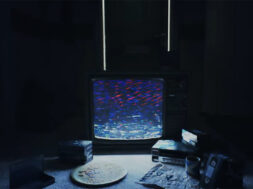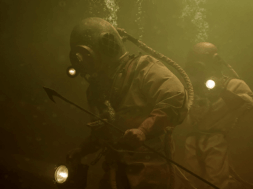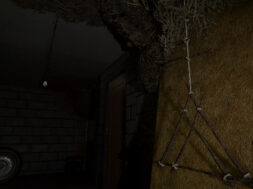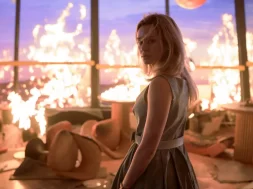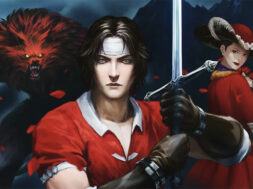Horror games usually aren’t a lot of fun when you play them on a convention floor. Most of them work off of atmosphere and a sense of isolation, so you lose a lot of their intended impact when you’re surrounded by people in a brightly-lit room, with discordant music playing from the next booth over. (There really ought to be a “horror area” at shows like E3 or PAX, ideally in a poorly-maintained basement or abandoned warehouse nearby.)
When I sat down to play Pawel Kozminski’s World of Horror at the Penny Arcade Expo in Seattle, I wasn’t expecting much, mostly because it was in the middle of a Sunday-morning crowd. World of Horror still managed to be surprisingly creepy even in that environment, though, and I’ve been trying to put a finger on exactly why ever since.
It’s basically a glorified Hypercard stack, with graphics made entirely in MS Paint (this is not a humorous exaggeration), a simple turn-based combat system, and chiptune music that reminds me of the first Ninja Gaiden on NES. By rights, it should be too campy to be truly scary, even if I’d been playing it in an ideal environment, but it’s stuck with me for the last few days.

A lot of it is that World of Horror isn’t really using anything from the traditional video game horror toolbox, like audio design, slow builds, or sudden shocks. Instead, it’s depicting a series of environments where everything is none-too-subtly wrong. Every building’s decorated like a recent murder scene, and every bystander looks deformed even when they aren’t explicitly monstrous. Both the available scenarios at PAX were about exploring mundane locations in search of the horrors hidden inside them, and in both cases, those horrors were weirdly easy to find.
World of Horror is set in a small seaside village in 1980s Japan, where the imminent awakening of the Old Gods is driving the locals insane when it isn’t transforming them into monsters. It’s the end of the world, and as one of five playable characters who haven’t quite managed to go crazy yet, you’ve got a front-row seat.
The game is built as a “roguelite.” When you start, you go through the first of five possible mysteries, out of a total pool of 15 to 20. Each of the mysteries “feed off of each other,” according to Kozminski, and several of them are open-ended. In theory, when and if you reach the end of the fifth one, you may be in a position to do something about the end of the world.
Naturally, you’re a lot more likely to get slit up the middle by a crazed girl with scissors before you reach that point. World of Horror is not a subtle game.

The two scenarios at PAX were both set up as if they were at least the second mystery in a given run. The first involved searching through an empty high school for the tools needed to complete a particular ritual; the second put you in the role of a young girl, attending the wake of a distant uncle in an isolated mansion. In both cases, they started with informing you that they took place after you’d escaped from something called a “skin hag,” which, well, yeah. That probably wasn’t great.
The flow of both mysteries was simple. You get dropped at the start of a scenario in a relatively safe area, then given your first goal. At this point, you hit a button to search the area, which produces a random encounter. That might be finding a new area, discovering a static event, or running into an enemy.
As you go, you have a chance of gaining or losing points in a percentage-based stat called Doom, which seems to represent the effect that your actions are having on the imminent apocalypse. You can gain it by witnessing terrible things or reading the wrong books, or lose it by burning that human-skin scroll without opening it. If your Doom hits 100%, Kozminski told me at PAX that you’ll either trigger a game over, or end up in a big, potentially unwinnable boss fight.
When hostilities start, World of Horror goes into a turn-based combat mode, which is also arguably the weakest part of the game. You have two stats to track during a fight, Health, and Reason, and enemies’ attacks can sap one or both of them.
You can punch or kick to score light damage at a high hit chance, or equip weapons like knives, axes, or bats (firearms are available, but I never found one in the demo) for more damage but a higher chance of missing. You’ve got a certain amount of time per turn, with each action taking up a set amount, so you can suddenly burst out into four consecutive unarmed attacks if you want to burst an enemy down.
In practice, combat quickly degenerates into throwing one punch and using one defensive action, usually dodging, every turn. Once your target’s at low life, you can punch them a few times to finish them off. It’s a little boring, like old ‘90s JRPGs where you hold down the basic attack button on random encounters so you don’t burn useful resources on the cannon fodder.

The rest of each investigation is a lot more interesting, though. World of Horror wears its influences on its sleeve, being one part H.P. Lovecraft to one part Junji Ito, and as it turns out, that’s a potent combination.
One of my takeaway points from last year’s Call of Cthulhu, by Cyanide Studios, is that video games, in particular, have hit a sort of Lovecraft saturation point. It’s not really enough to do a straightforward adaptation or homage, because everyone but the newest fans have all seen that a few times by now. There are cultists in the basement, Deep Ones in the water, and bad secrets in the library, because there always are; Cthulhu himself is 0 and 1 against the Real Ghostbusters. We know this song by heart.
World of Horror changes the script not just by switching out the setting for suburban Japan, but by adding in Ito’s style to taste. There’s no slow build in World of Horror, or inevitable foray into the ancient ruins. The monsters are twisted but still identifiably human, and the worst places in the game are also the most ordinary. I wouldn’t have expected Ito- and Lovecraft-style horror to blend together this well, but now that I’ve seen it, I’m not sure how I could’ve thought anything else.
I do have a few questions left over from the demo, of course. The UI in World of Horror isn’t amazing, and I wonder how well the mysteries will actually connect with one another in the final version. I’d also hope that the combat’s a little livelier, as the random encounters can either be far too punishing or go on for far too long.
Just as a scary experience, though, I can’t wait to get into World of Horror and pick it apart. It probably shouldn’t work this well, and there’s potentially a lot to learn from it.
